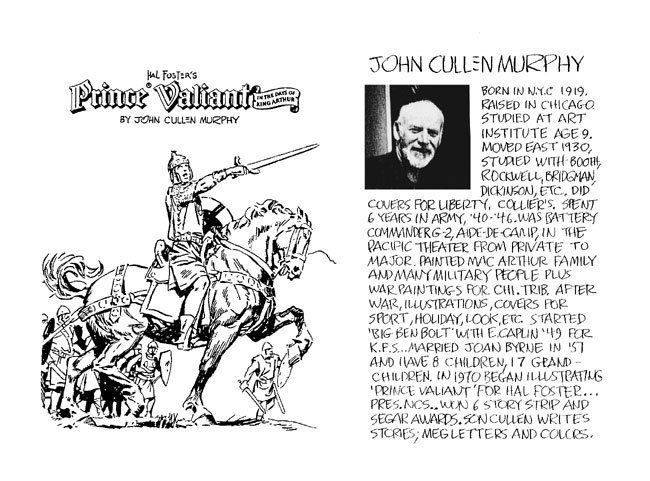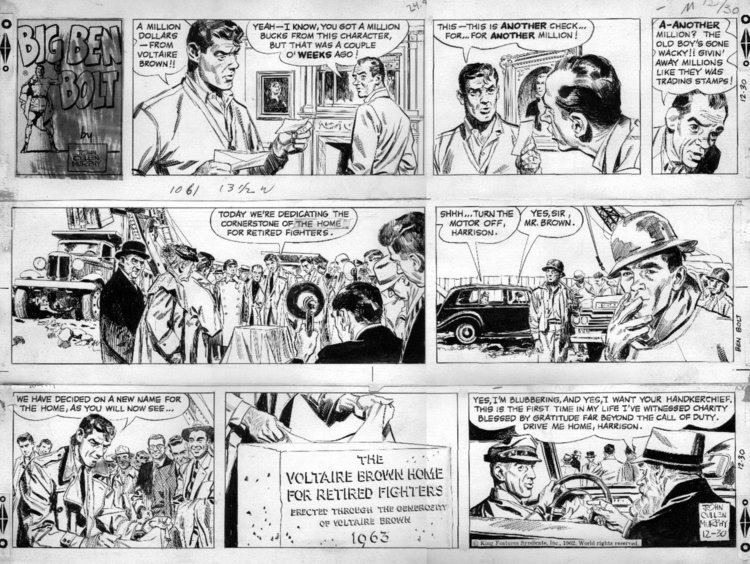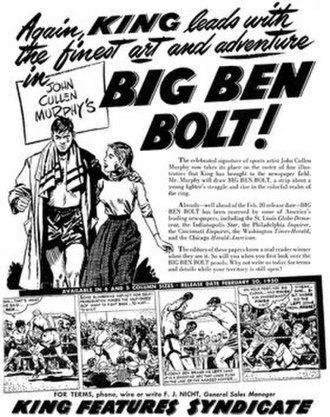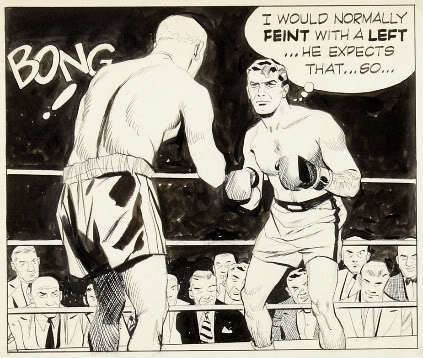Nationality American Spouse(s) Joan Byrne | Name John Murphy | |
 | ||
Died July 2, 2004, Greenwich, Connecticut, United States Books John Cullen Murphy's Big Ben Bolt: Dalies, Big Ben Bolt: February 20, 1950 to May 24, 1952 | ||
John Cullen Murphy (May 3, 1919 – July 2, 2004) was an American illustrator best known for his three decades of work on the Prince Valiant comic strip.
Contents
- Early life and education
- Army service
- Magazine illustration
- Big Ben Bolt
- Prince Valiant
- Family
- Skills
- Awards
- References

Early life and education

Born in New York City, Murphy spent his childhood in Chicago and in New Rochelle, New York, where his family moved in 1930.

He started art classes at the age of 9, but aspired to be a baseball player. He received supervision from artists like George Bridgman, Norman Rockwell, Charles Chapman and Franklin Booth. He was playing baseball one afternoon when he got attention of Norman Rockwell, his New Rochelle neighbor and asked the 15-year-old if he would like to pose for some magazine ads. Rockwell discovered John's keen interest in art after doing few illustrations with him. Rockwell's Starstruck, showing a forlorn Murphy gazing at pictures of movie starlets, was the September 22, 1934 cover of The Saturday Evening Post. The experience inspired the young Murphy to become an illustrator. Rockwell became one of his good friends and mentors. Murphy started his career early, selling his first illustrations while he was still in high school. After high school, he studied in New York City at the Phoenix Art Institute and the Art Students League, where he was taught by the anatomist George Bridgman. He further pursued his art career drawing spot illustrations for the Chicago Tribune while serving in W.W.II as well as painting portraits of well-known military personnel including General Douglas MacArthur.
Army service

Murphy entered the U.S. Army in 1940, joining the 7th Regiment. He became an anti-aircraft officer during World War II, rising to the rank of major. He spent several years in the Pacific, beginning in Australia and ending in Tokyo. He was an aide to General William F. Marquat, who was on General Douglas MacArthur's staff. During the war, Murphy continued to illustrate, sending work to the Chicago Tribune and painting numerous portraits of military figures.
Magazine illustration

Murphy's first professional work at the age of seventeen was for Madison Square Garden's publicity department drawing boxing cartoons. On average two of his cartoons a week were published by sports magazines in Chicago. Murphy resumed his art career upon his return from military service. During the 1940s, Murphy was a popular magazine illustrator, regularly seen in Collier's, Look, Esquire, Liberty, Sport, Holiday and Columbia, published by the Knights of Columbus.
Big Ben Bolt
Murphy's art often depicted sports subjects. His boxing material unexpectedly led him into the comic strip field, something he had never previously considered. In 1950, writer Elliot Caplin (brother of cartoonist Al Capp) of King Features Syndicate asked Murphy to illustrate a boxing comic strip he was planning to write. Murphy accepted his invitation. The resulting daily comic strip, Big Ben Bolt, was launched in 1950 and ran until 1978. Murphy was the artist for the strip for its entire run. Murphy's strong interest in boxing and sports background made the strip a real knockout with his fans. His vast experience as an illustrator and cinematic approach made any possible situation or local seem realistic and effective.
Prince Valiant
Murphy began his collaboration on Prince Valiant (the saga of a young Norse prince who becomes a knight of King Arthur's round table at Camelot) with creator Hal Foster in 1970 when Foster decided to lessen his workload at age 78. From the fall of 1970 until early 1980 Foster would give a nicely penciled layout for Murphy to complete and be published. With Foster's retirement in 1979, Murphy's son Cullen took over the writing. Cullen Murphy began contributing stories to Foster while studying at Amherst College. Bill Crouch also contributed six story lines over the next four years to the historic strip. Murphy continued to draw Prince Valiant with his son scripting and his daughter doing the lettering and coloring. He retired in March 2004, turning the strip over to his chosen successor, illustrator Gary Gianni. Murphy died four months later in Cos Cob, Connecticut.
Family
In 1951, Murphy married Joan Byrne, also from New Rochelle. They had eight children. Murphy and his family worked on Val's adventures for thirty-four wonderful years and later it was handed over to the current artistic team.
Skills
Murphy was very creative and artistic in its own way. Foster's distinctive style was never copied by Murphy. Murphy always preferred harder pen line instead of softer brush look which helped in giving angular feel than its original creator's version. Frank Bolle would help Murphy in layouts and research but Murphy's detailed pen work could still be seen in all the finished pages. Expressions on the characters faces highlighted Murphy's superior illustrative skills. Murphy had massive reference materials and library of books which were given by Foster helped in making the episodes fresh with its many historical characters and places. Murphy's talent and professionalism helped in maintiang the worldwide popularity of Prince Valiant. The country is fortunate enough that Murphy gave up his sports ambitions to become one of the most respected and thought of cartoonists in America.
Awards
For his work on Big Ben Bolt and Prince Valiant, Murphy was honored with the National Cartoonists Society's Story Comic Strip Award in 1971 and again for Prince Valiant in 1974, 1976, 1978, 1984 and 1987. He received the Elzie Segar Award in 1983.
